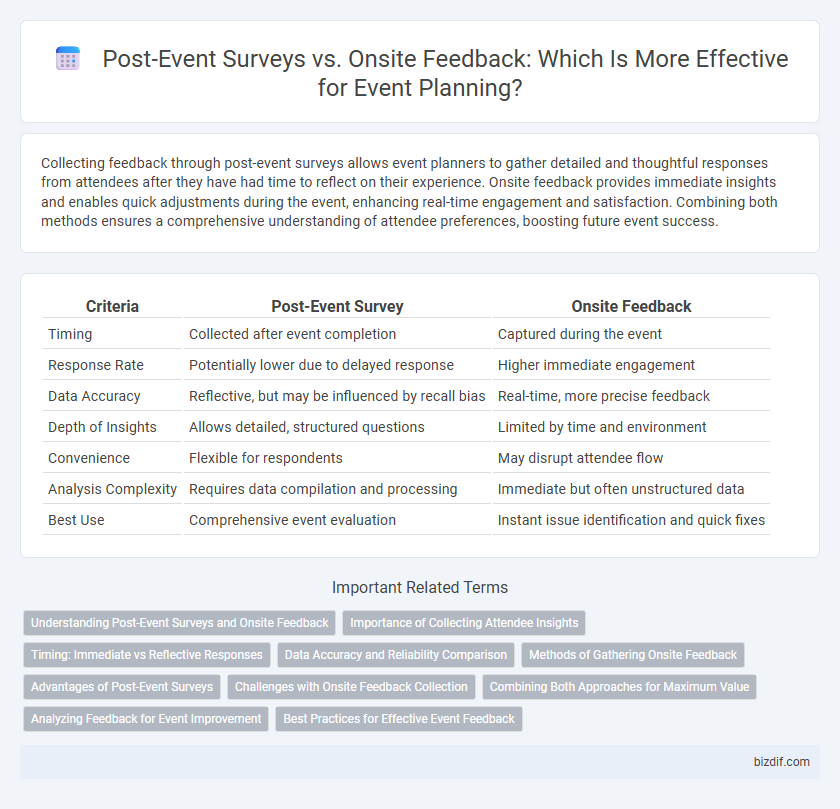Collecting feedback through post-event surveys allows event planners to gather detailed and thoughtful responses from attendees after they have had time to reflect on their experience. Onsite feedback provides immediate insights and enables quick adjustments during the event, enhancing real-time engagement and satisfaction. Combining both methods ensures a comprehensive understanding of attendee preferences, boosting future event success.
Table of Comparison
| Criteria | Post-Event Survey | Onsite Feedback |
|---|---|---|
| Timing | Collected after event completion | Captured during the event |
| Response Rate | Potentially lower due to delayed response | Higher immediate engagement |
| Data Accuracy | Reflective, but may be influenced by recall bias | Real-time, more precise feedback |
| Depth of Insights | Allows detailed, structured questions | Limited by time and environment |
| Convenience | Flexible for respondents | May disrupt attendee flow |
| Analysis Complexity | Requires data compilation and processing | Immediate but often unstructured data |
| Best Use | Comprehensive event evaluation | Instant issue identification and quick fixes |
Understanding Post-Event Surveys and Onsite Feedback
Post-event surveys provide detailed insights by collecting attendee opinions and satisfaction levels after the event, enabling comprehensive analysis of overall experience and improvement areas. Onsite feedback captures real-time reactions during the event, offering immediate data to address issues quickly and enhance speaker or session engagement. Combining both methods allows event planners to obtain a well-rounded understanding of attendee preferences and event success metrics.
Importance of Collecting Attendee Insights
Collecting attendee insights through post-event surveys and onsite feedback is crucial for understanding participant satisfaction, engagement, and areas for improvement. Post-event surveys provide comprehensive data that can be analyzed to measure overall event success and guide future planning strategies. Onsite feedback captures immediate reactions, enabling real-time adjustments and enhancing the attendee experience during the event.
Timing: Immediate vs Reflective Responses
Post-event surveys allow attendees to provide reflective responses after processing their overall experience, often yielding detailed insights days later, which helps in identifying long-term event impacts. Onsite feedback captures immediate reactions during the event, offering real-time data that can be used for quick adjustments and understanding participant emotions as they occur. Combining both methods balances the advantage of prompt, actionable feedback with comprehensive, considered evaluations.
Data Accuracy and Reliability Comparison
Post-event surveys offer comprehensive insights with enhanced data accuracy due to their structured design and participant reflection time, ensuring reliable feedback across a broad audience. Onsite feedback captures immediate reactions but often lacks consistency and may be influenced by event-day emotions, reducing its reliability for long-term analysis. Combining both methods can optimize data validity by balancing real-time impressions with thoughtful, post-event evaluations.
Methods of Gathering Onsite Feedback
Effective onsite feedback methods during event planning include real-time digital surveys via tablets or apps, interactive kiosks strategically placed, and direct verbal interviews with attendees. These techniques capture immediate reactions, enhancing data accuracy compared to post-event surveys collected later. Utilizing QR codes linking to brief feedback forms also encourages higher response rates onsite.
Advantages of Post-Event Surveys
Post-event surveys provide comprehensive insights by allowing attendees to reflect and offer detailed feedback beyond the constraints of real-time interactions. They enable event planners to gather quantifiable data on overall satisfaction, session relevance, and logistical effectiveness, supporting data-driven decisions for future events. Unlike onsite feedback, post-event surveys increase response rates through targeted reminders and can include diverse question types for nuanced analysis.
Challenges with Onsite Feedback Collection
Collecting onsite feedback during events often faces challenges such as attendee distraction, time constraints, and limited engagement leading to incomplete or biased responses. Unlike post-event surveys that allow respondents to reflect and provide detailed input, onsite feedback can be rushed and superficial due to the event's dynamic environment. Technical issues with devices and network connectivity also complicate real-time data collection, reducing the overall quality and reliability of the feedback obtained onsite.
Combining Both Approaches for Maximum Value
Post-event surveys provide comprehensive insights by gathering attendee opinions after reflection, while onsite feedback captures immediate reactions and engagement levels during the event. Combining both approaches maximizes data accuracy and depth, enabling event planners to address real-time issues and improve future experiences effectively. Leveraging digital tools for seamless integration of onsite and post-event feedback enhances overall event success and attendee satisfaction.
Analyzing Feedback for Event Improvement
Post-event surveys provide comprehensive insights by collecting detailed attendee feedback after event completion, allowing organizers to analyze satisfaction trends and identify areas for future improvement. Onsite feedback captures immediate reactions, useful for addressing real-time issues and making swift adjustments during the event. Combining both methods enhances the accuracy of feedback analysis, leading to more effective event planning and elevated attendee experience.
Best Practices for Effective Event Feedback
Post-event surveys offer comprehensive insights by allowing attendees to reflect and provide detailed feedback on all aspects of the event, resulting in higher-quality data for improving future planning. Onsite feedback captures immediate reactions and emotions, enabling real-time adjustments and enhancing attendee experience during the event itself. Combining both methods ensures a holistic approach to event feedback, maximizing accuracy and actionability for event organizers.
Post-event survey vs Onsite feedback Infographic

 bizdif.com
bizdif.com